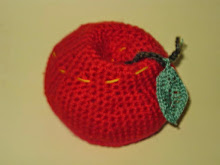

This photo is such a beauty and it happened at a numinous moment in my garden.
Arid Australia and last February 2010 we had such a lot of rain!
There were butterflies floating through the garden and I wished I could have a photo of one.
As if it knew my thoughts, this Common Brown settled in a patch of sunlight near my right foot and I was able to put my new camera on macro and take this lovely shot. It felt like a blessing.
The knitted flowers can't be enlarged (photo is fixed).
Why do I put this in a blog on hyperbolae?
Answer is I can't resist the interplay of Heterodontus and Heteronympha.
(I know scientific names should be underlined, but I don't know how to do it.)
Plus there is a spin off from Heterodontus and it was quite unexpected:-
I used the long stitch, treble or double treble when crocheting the 5, 25, 125, 625 series.
ie 1, then 2, then 3, then 5.
Here it is, knitted. It's a bit tricky, because it does matter if you knit into the front or back of the stitch. You need to play with it to get it right.
It looks like a tubular flower. Just sew it together, and make yellow stamens etc for inside, add green stem and leaves.
The plain side can be inside or outside the flower.
So a whole corsage was made, to give as a gift to a dear friend on her 60th birthday, Hello Jan!
Oh dear- the photo won't allow itself to come down to this level on the page and I don't know how to fix it, so let's leave it where it is.
Here are the instructions to knit these flowers:-
Cast on 25 stitches in a pretty colour. Actually correction 2/1/2015. it is 23 to begin.
knit 2 together twice, knit one; continue to end of row in this pattern, makes 15 stitches; turn.
purl 2 together, purl 1; repeat till end of row, makes 10 stitches; turn.
knit 2 together, 5 times, makes 5 stitches,
break thread and tie on green thread, ot wool.
purl 2 tog, twice, purl 1, makes 3 stitches
knit 2 tog, knit 1, makes 2 stitches
purl 2 tog, makes 1.
Continue on making some chains to make the stem.
make a leaf by knitting 5, then 3, then2, then 1, then add it to stem, knitting both together, and doing some more chains to lengthen stem,
Finish off. Sew flower part together in colour. Sew green sepal part together.
Make more of these and have a bunch of pretty flowers.
I used number 12 knitting needles and 1 or 2 ply fine tapestry wool (English, Applemore) but you can use any yarn at all. You could crochet them also, I guess, working from 1 stitch and reading the pattern backwards, increasing, knit 2 together to get 5, 10, 15, 25. (5x 1, 2, 3, 5.)
I do hope this pattern is OK to understand. It is Fibonacci again, ie, 1, 2, 3, 5.
***2/1/2015 I have re posted this Pattern recently in "some people and the models they make"
---------------------------------------------------
***2/1/2015 I have re posted this Pattern recently in "some people and the models they make"
---------------------------------------------------


No comments:
Post a Comment